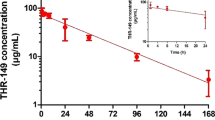Abstract
Objective: To characterize the pharmacokinetics and pharmacodynamics of acetazolamide in patients with transient intraocular pressure (IOP) elevation and to provide individual patients with the optimal dosage regimen for this drug.
Methods: We studied 17 patients with transient IOP elevation, who were given 62.5–500 mg acetazolamide orally as single or repetitive doses. Plasma acetazolamide concentration and IOP were measured at approximately 1, 3, 5, and 9 h after the last acetazolamide administration. Pharmacokinetics and pharmacodynamics were analyzed by nonlinear mixed-effect modeling using the program NONMEM.
Results: The plasma concentration profile of acetazolamide was characterized by a one-compartment model with first-order absorption. The apparent oral clearance was related to the creatine clearance (CCR) which was estimated by the Cockcroft and Gault equation, as follows: 0.0468 · CCR l · h−1. The estimated apparent oral volume of distribution, first-order absorption rate constant, and absorption lag time were 0.231 l · kg−1, 0.821 · h−1, and 0.497 h, respectively. IOP after oral acetazolamide administration was characterized by an Emax model. The maximal effect in lowering the IOP (Emax) was 7.2 mmHg, and the concentration corresponding to 50% of the maximal effect (EC50) was 1.64 μg · ml−1. As 70% of Emax was achieved at a plasma concentration of 4 μg · ml−1, this concentration was considered satisfactory for lowering IOP. The recommended dosage was calculated so that the minimum plasma concentration at steady state exceeded this target concentration; 250 mg t.i.d., 125 mg t.i.d., 125 mg b.i.d., and 125 mg once daily for the patients with CCR values of 70, 50, 30, and 10 ml · min−1, respectively.
Conclusion: Measuring plasma concentrations of acetazolamide and subsequent pharmacokinetic and pharmacodynamic analyses are useful for estimating its concentration-dependent effectiveness in lowering the IOP in individual patients. The dosage regimen presented in this study is expected to improve the benefits of acetazolamide pharmacotherapy in most elderly patients with transient rises in IOP following intraocular surgery.
Similar content being viewed by others
Author information
Authors and Affiliations
Additional information
Received: 10 April 1997 / Accepted in revised form: 21 October 1997
Rights and permissions
About this article
Cite this article
Yano, I., Takayama, A., Takano, M. et al. Pharmacokinetics and pharmacodynamics of acetazolamide in patients with transient intraocular pressure elevation. E J Clin Pharmacol 54, 63–68 (1998). https://doi.org/10.1007/s002280050422
Issue Date:
DOI: https://doi.org/10.1007/s002280050422




